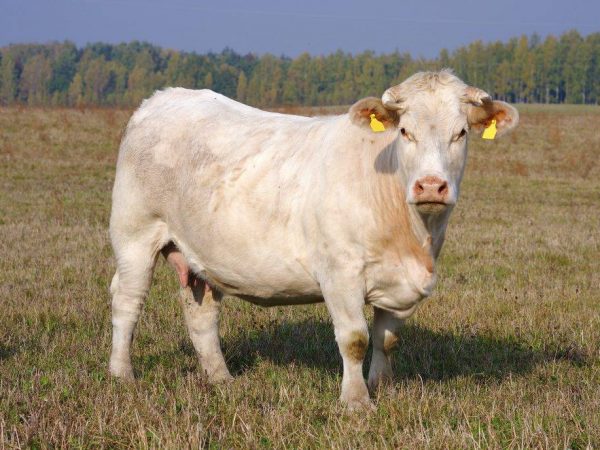Charolais cow breed
The Charolais cattle breed, bred in the process of long-term selection work, is started by farmers in order to obtain excellent quality meat from it and for use in crossing with other cattle when obtaining hybrid lines.

Charolais cow breed
About Charolese cattle
The French began to engage in the Charolais cattle breed in the 17th century, taking as a basis the breeds of local animals, which differed in productivity and external characteristics.
Initially, the ancestors of Charolais cows and bulls were of a mixed type, they combined both dairy and meat trends, having a set of working qualities. For a long time, Charolais bulls were used as draft animals. Compared to the representatives of the breed existing today, their ancestors were not so much developed as the current generation, but had a strong immune system.
The Charolais breed of cows was entered in the register as an independent type in 1864.
It became possible to switch to a new type of cattle only since the 1920s, when massive Simmentals and the Shorthon species were chosen as objects for crossing. The selection of cows and bulls used for procreation began to be made taking into account their body weight and growth intensity.
The largest population of Charolais cows today is located in France and has about 2 million individuals. In addition, it is possible to meet the Charolese breed on farms in 7 dozen more countries where this cattle is used in the process of improving the quality of other cattle. The Russian Charolais population numbers just over a thousand representatives, which are in the Tver, Belgorod regions, Stavropol and Tyumen.
Characteristics of the standard
The formation of the exterior of the Charolais breed took place over a long period, as a result of which animals of the meat direction appeared, having a massive constitution with pronounced developed muscles. They do not accumulate a large amount of subcutaneous fatty tissue, therefore they give out dietary meat. The description of the breed includes its own distinctive features:
- the weight of animals ranges from 0.9 to 1.7 tons (bulls) and from 0.7 to 1.0 tons (heifers), often larger animal sizes are recorded,
- the body weight of newborn calves is up to 70 kg,
- the Charolais cow grows up to 1.55 m at the withers, the bull - up to 1.65 m, reaching 2.2 m obliquely in bulls and up to 1.9 m in heifers,
- the girth of the chest of the animal is on average 2.0 m or more,
- white suit with a light-colored nose,
- wide frontal bone, small horns,
- low, well-built limbs.
In the conditions of a private farm, the Charolese cattle retain their qualities for operation for 15 years, while maintaining the functions of reproduction, bringing milk and acting as a draft force.
Productivity indicators, advantages and disadvantages
Considering that the Charolese line of cows is of the beef type, its main purpose is to bring quality meat, and in this the cattle fully justifies the hopes of the farmers. Newborn calves weigh from 30 kg, intensively gaining good weight until the age of two, 1.0-2.0 kg per day. By the age of six months, the calf gains weight up to 0.25 tons.
The Charolais breed gained popularity thanks to record indicators of slaughter, live weight and growth rates.
Slaughter meat yield from a matured animal ranges from 65% or more. Lean beef has good flavor and texture characteristics.
In addition, Charolais cows give good indicators of milk production. Annual milk yields of their fatty dairy products (up to 4.0-4.1% fat) remain in the range of up to 2.5 tons, sometimes providing up to 3.0 tons.
Advantages and disadvantages for breeding
For keeping as a producer, the Charolese breed of cows has a number of advantages:
- its representatives are distinguished by good heredity, securing good quality characteristics in subsequent generations,
- Cattle quickly adapt to the updated living conditions, adapting in a short time of acclimatization,
- charolais belong to pasture animals, which significantly reduces the cost of their maintenance in summer,
- long life expectancy allows you to use Charolese cattle as useful and rational as possible,
- the breed is distinguished by high rates of productivity,
- as a result of the slaughter of young animals, the proportion of lean meat significantly exceeds the fat content.
As disadvantages, farmers point to some specific external signs, including the unevenness of the dorsal region and bifurcation of the shoulder blades. In addition, there were cases of heavy calving due to the large size of the calves. In cows of the Charolais breed, fertility is greatly influenced by muscular hypertrophy of the posterior part of the trunk, which is of a pathological nature, therefore infertile animals are sometimes found.


